How to Grow and Care for Broccoli: Expert Secrets for a Thriving Crop
- May 7, 2024
- 0 comment
Discover expert tips on how to grow and care for broccoli to ensure a thriving, healthy crop every season. Dive into the world of broccoli gardening with our expert guidance. Discover essential tips on how to grow and care for broccoli, ensuring a thriving, healthy crop through every season.
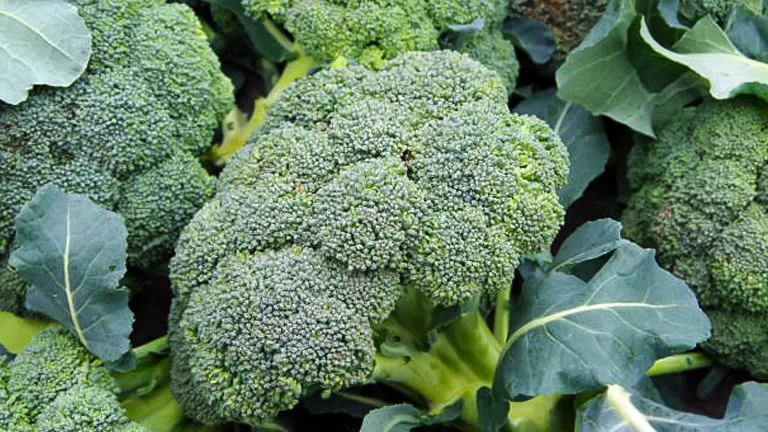
From choosing the right seeds to optimizing your watering schedule, this article covers all you need to know to become a successful broccoli grower. Start your gardening journey with confidence and watch your crops flourish
Table of Contents
- Broccoli’s Origins and Global Impact
- Selecting the Right Broccoli Varieties
- Soil Preparation and Planting
- Planting Techniques and Early Growth Care
- Monitoring Early Development
- Mid-Growth Practices and Pest Management
- Pest and Disease Management
- Harvesting and Post-Harvest Care
- Final Tips for Success
- Conclusion
- FAQs
Broccoli’s Origins and Global Impact
Historical Background
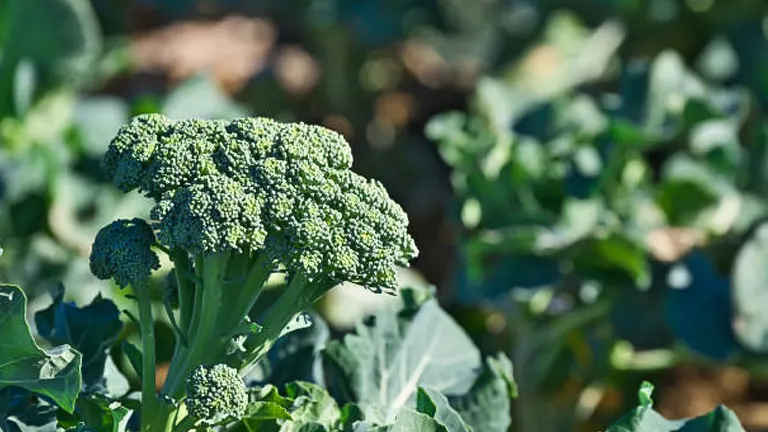
Broccoli, a member of the Brassica family, originated in the northern Mediterranean region, where it was developed from wild cabbage by selective breeding. Its name is derived from the Italian word “broccolo,” meaning “the flowering crest of a cabbage.” Broccoli was well-known to the Romans and was highly valued for its medicinal properties and flavor. Ancient Romans praised it for its ability to improve digestion, while Pliny the Elder documented its usage in his writings.
During the Middle Ages, broccoli remained a regional specialty in Italy, eventually spreading across Europe as explorers and traders returned with seeds and tales of this delicious vegetable. Its introduction to England in the 18th century earned it the nickname “Italian asparagus,” but its appeal remained relatively niche until the early 20th century.
Cultural Adoption and Adaptation
The cultivation of broccoli expanded significantly in the 16th century, particularly in Italy and later France. It was introduced to the United States by Italian immigrants in the early 1900s, who brought their agricultural knowledge and seeds to America. Commercial cultivation started in California, which quickly became the epicenter of broccoli farming due to its favorable climate. By the mid-20th century, broccoli gained popularity as scientific research highlighted its nutritional value, and it became a staple in households and restaurants.
Today, broccoli is a global vegetable, grown extensively in China (the largest producer), India, the United States, and Europe. Each region adapts cultivation methods to its climate, soil, and agricultural practices. In China, broccoli is often stir-fried or used in soups, while in Western cultures, it is more commonly steamed or roasted. Indian cuisine includes broccoli in curries and mixed vegetable dishes, showcasing its versatility.
Culinary Uses
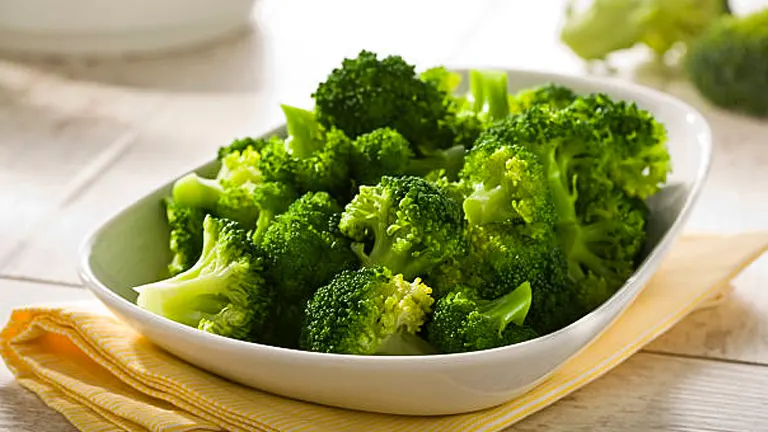
Broccoli’s versatility and mild, slightly bitter flavor have made it a global culinary favorite. It’s used raw in salads, steamed as a side dish, roasted to bring out its natural sweetness, and stir-fried with other vegetables. In Mediterranean cuisine, broccoli pairs well with olive oil, garlic, and lemon, while in Asian dishes, it’s stir-fried with soy sauce, ginger, and sesame oil.
Its adaptability to different cooking techniques and ability to complement a wide range of flavors make it indispensable in modern cuisine. Beyond the florets, broccoli stems are also edible, often peeled and sliced for stir-fries or used in soups to reduce food waste and maximize the vegetable’s potential.
Nutritional Value and Health Benefits
Broccoli is celebrated for its dense nutritional content. One cup of raw broccoli (about 91 grams) provides 135% of the recommended daily intake of vitamin C and 116% of vitamin K. It’s also rich in fiber, folate, and antioxidants like sulforaphane, a compound known for its potential cancer-fighting properties. Its anti-inflammatory and detoxifying compounds have been linked to improved heart health and a reduced risk of chronic diseases.
Selecting the Right Broccoli Varieties

Selecting the appropriate variety of broccoli to grow is not just about flavor preferences—it also impacts yield, resilience, and adaptability to environmental conditions. Here, we delve deeper into the characteristics of popular broccoli varieties and how they perform under different climatic conditions, complete with a detailed table that includes scientific data to aid in your decision-making.
Detailed Variety Analysis
- ‘Calabrese’: Often referred to as the Italian Green, this variety is renowned for its large, dark green heads and robust flavor. It has a relatively long growing season, typically requiring about 65 to 70 days to harvest from transplantation. It’s well-suited to a broad range of climates but performs best in areas where daytime temperatures are consistently below 75°F.
- ‘Romanesco’: This variety is noted for its remarkable geometric, fractal-shaped head and a milder, nuttier flavor than most other varieties. Romanesco requires similar growing conditions to ‘Calabrese’, but its visual appeal and unique texture make it a gourmet choice for gardeners and chefs alike. It typically matures in about 75 to 80 days from transplantation.
- ‘Purple Sprouting’: Hardy and resilient, ‘Purple Sprouting’ broccoli is excellent for colder climates. It is a late-season variety that matures over a longer period, which can extend up to 220 days, making it ideal for continuous harvesting. It’s known for its high levels of anthocyanins (the pigments that give it its purple color), which have potent antioxidant properties.
Climate Considerations
Broccoli’s performance is significantly influenced by temperature. Optimal growth occurs between 65°F and 75°F, but each variety has its own specific tolerance to temperature extremes. Here’s a closer look at how temperature affects broccoli development:
- Bolting: This premature flowering is often triggered by temperature fluctuations. If temperatures rise above 75°F for extended periods, even cold-tolerant varieties like ‘Purple Sprouting’ may bolt before producing a full head.
- Heat Tolerance: Some newer hybrid varieties are bred for improved heat tolerance and may be better suited for warmer climates. For example, ‘Belstar’ and ‘Green Magic’ are known for their ability to produce quality heads even when temperatures spike.
Comparative Table of Broccoli Varieties
| Variety | Maturity (Days from Transplant) | Optimal Growing Temp (°F) | Unique Traits | Recommended Climate |
|---|---|---|---|---|
| Calabrese | 65-70 | 60-75 | Large heads, traditional flavor | Temperate |
| Romanesco | 75-80 | 60-75 | Fractal heads, nutty flavor | Temperate, Cool |
| Purple Sprouting | Up to 220 | 55-70 | Hardy, continuous harvest, high antioxidants | Cold |
| Belstar | 65-70 | 65-85 | Heat tolerant, uniform heads | Warm, Temperate |
| Green Magic | 60-65 | 60-85 | Heat and cold tolerant, early maturing | Diverse |
This detailed analysis and comparison should help gardeners choose the right broccoli variety based on scientific metrics and unique traits, ensuring that each gardening endeavor is optimized for both environmental conditions and culinary preferences.
Soil Preparation and Planting
Soil Requirements and Preparation

Broccoli thrives in well-aerated, nutrient-rich soil, making soil preparation a critical step in ensuring the health and productivity of your crop. Here’s a more detailed approach to preparing your soil:
- Broccoli performs best in loamy soils that combine sand, silt, and a good amount of clay, providing both drainage and nutrient retention. If your soil is heavy clay or too sandy, amend it with organic matter. Adding compost not only improves fertility but also enhances the soil structure, increases water retention in sandy soils, and improves drainage in clay soils.
- The ideal pH for broccoli is slightly acidic to neutral, between 6.0 and 7.0. Conduct a soil test to determine your soil’s pH and nutrient levels. Adjust the pH using lime if the soil is too acidic or sulfur if it is too alkaline. A balanced supply of macro-nutrients (nitrogen, phosphorus, and potassium) and micro-nutrients (calcium, magnesium, and sulfur) is crucial. For instance, nitrogen promotes leaf growth, phosphorus supports root development, and potassium enhances overall plant health.
- Integrate well-rotted manure or compost into the soil about 2-3 weeks before planting. This addition enriches the soil with organic nutrients and beneficial microbes that aid in root development and improve soil structure. Consider incorporating a slow-release, balanced fertilizer according to the soil test recommendations to ensure a continuous supply of nutrients.
Planting and Timing
- Begin by planting seeds indoors in biodegradable pots 6-8 weeks before the last expected frost. This allows seedlings to develop without interruption when transplanted. Keep the soil moist and provide ample light—either natural or through grow lights—to prevent leggy growth.
- Harden off seedlings by gradually exposing them to outdoor conditions over 7-10 days to reduce transplant shock. Transplant when seedlings have 4-6 true leaves and night temperatures consistently stay above freezing. Plant seedlings deeper than they were in pots to encourage more stable, robust growth.
- For regions with a long growing season, direct sowing can be more beneficial. Plant seeds 1/2 inch deep and space them about 3 inches apart. Thin seedlings to 18 inches apart once they reach 2-3 inches in height. This spacing allows ample room for each plant to mature and prevents competition for nutrients and light.
Soil Preparation and Planting Table for Broccoli
| Aspect | Ideal Condition | Specific Actions and Measures |
|---|---|---|
| Soil Type | Loamy and well-draining | Amend with 30-40% compost if too sandy or clay-heavy. |
| Soil pH | 6.0 – 7.0 | Test soil pH annually; adjust using lime if below 6.0 or sulfur if above 7.0. Apply amendments as per soil test results, typically around 50 lbs per 1,000 sq ft to adjust pH by 0.5. |
| Organic Matter | High organic content | Incorporate 2-4 inches of compost or well-rotted manure into the top 6-8 inches of soil. |
| Nutrients | Balanced NPK, adequate Ca, Mg, S | Apply a balanced slow-release fertilizer (e.g., 10-10-10) at a rate of 3 lbs per 100 sq ft pre-planting. Supplement with additional nitrogen if leaves are pale. |
| Planting Depth | 1/2 inch for seeds, 1 inch for transplants | Sow seeds 1/2 inch deep. Transplant seedlings so that the lower set of leaves is just above the soil surface. |
| Seedling Spacing | 18 inches apart in rows 24-36 inches apart | Thin seedlings to 18 inches apart to optimize light exposure and air circulation. |
| Germination Temperature | 65°F – 75°F | Maintain greenhouse or indoor temperatures within this range for optimal germination. |
| Watering | 1 to 1.5 inches per week | Implement drip irrigation or use a soaker hose to provide deep, consistent watering without wetting foliage. Mulch with straw or shredded bark to retain moisture. |
Planting Techniques and Early Growth Care
Planting Techniques
Direct Sowing vs. Transplanting: Broccoli can be started either by direct sowing into the garden or by transplanting young seedlings that have been started indoors. The choice depends largely on your climate and the length of your growing season.
- Direct Sowing: This method is suitable for areas with long growing seasons. Sow seeds directly in the soil where they will mature. Plant seeds about 1/2 inch deep, spacing them 2-3 inches apart. Once seedlings are a few inches tall, thin them to stand 18 inches apart, which allows ample room for growth and air circulation.
- Transplanting: In cooler climates, start seeds indoors about 6-8 weeks before the last expected frost. Use a high-quality seed starting mix in trays or pots. Keep the soil consistently moist and provide plenty of light. Once seedlings have 4-6 true leaves and are about 6 inches tall, they’re ready to be transplanted outdoors. Harden off the seedlings by gradually exposing them to outdoor conditions over a week to reduce shock.
Spacing Requirements: Proper spacing is critical for optimal growth and yield. Space transplants or thinned seedlings 18-24 inches apart in rows that are 24-36 inches apart. This spacing allows for sufficient sunlight and air penetration, which are crucial for healthy development and disease prevention.
Early Growth Care
Watering Needs: Consistent moisture is key to developing strong and healthy broccoli plants. Aim to provide at least 1-1.5 inches of water per week, whether through rainfall or manual watering. Water the base of the plants deeply to encourage deep root growth, while avoiding wetting the leaves to reduce the risk of disease.
Nutrient Management: Two to three weeks after transplanting, apply a balanced, slow-release fertilizer to promote vigorous growth. Broccoli is a heavy feeder, particularly of nitrogen, which supports leafy growth. However, avoid over-fertilization, which can lead to rapid growth at the expense of head formation.
Protection Strategies: Young plants are vulnerable to pests and temperature extremes. Use floating row covers to protect them from common pests like cabbage worms and aphids. Row covers also help moderate temperature, protecting plants from harsh frosts and intense midday sun.
Monitoring Early Development
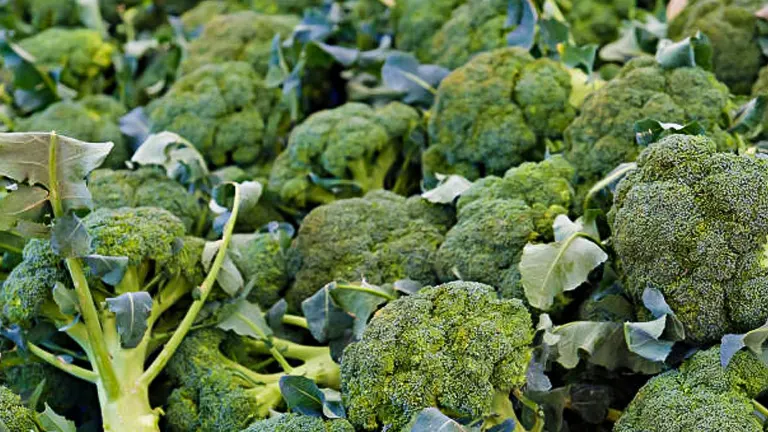
Regular Inspection
To ensure your broccoli plants thrive, it’s essential to conduct regular inspections. This proactive approach allows you to catch and address potential issues before they become serious. Here’s what to specifically look for during your inspections:
- Yellowing Leaves: This can indicate a variety of issues, including overwatering, under-watering, or a nutrient imbalance, particularly a lack of nitrogen.
- Stunted Growth: Slow growth could be due to inadequate sunlight, compacted soil, or insufficient nutrients.
- Holes in Leaves: Commonly caused by pests such as cabbage loopers and flea beetles. It’s crucial to identify the type of pest to choose the correct treatment method.
- Leaf Wilting: Can be a sign of either drought stress or a root problem. Check moisture levels and root health.
- Discoloration or Spots on Leaves: Often a sign of fungal infections or bacterial diseases.
By understanding these signs, you can take swift action to mitigate issues. For instance, yellowing leaves might require a soil test to adjust nutrient levels correctly, while holes in leaves could necessitate an organic pesticide or introduction of natural predators like ladybugs.
Adjustments and Interventions
Effective gardening requires adaptability based on ongoing plant observations and environmental conditions:
- Watering Adjustments: Broccoli requires consistent soil moisture. During dry spells, increase watering frequency to maintain moist but not soggy soil. Consider using mulch to help retain soil moisture.
- Nutrient Management: If plants appear pale or have stunted growth, it might be time to apply a balanced fertilizer. Additionally, side-dressing with nitrogen-rich fertilizer can help green up and boost plant growth. Perform a soil test to tailor your fertilization strategy to the specific deficiencies in your soil.
- Pest Management: If you detect pests, identify them accurately to choose the most effective control strategy. Options include mechanical removal, biological control (introducing natural predators), or safe, targeted organic pesticides. For example, Bacillus thuringiensis (Bt) is effective against many caterpillar species without harming beneficial insects.
- Disease Control: Preventative measures are key to managing plant diseases. Ensure good air circulation by spacing plants properly and pruning any crowded areas. Use fungicidal sprays only as needed and based on specific problems identified.
Documentation and Record Keeping
Keeping a garden journal can be invaluable in managing the health of your broccoli plants. Document:
- Weather Patterns: Record rainfall and temperature fluctuations to correlate with plant health changes or issues.
- Plant Growth Stages and Health: Note the dates of key growth stages and any signs of distress or disease.
- Interventions Made: Track what adjustments were made (watering, fertilizing, pest control) and the results, to refine your approach in the current and future growing seasons.
Mid-Growth Practices and Pest Management
Mid-Growth Care

Mulching: As your broccoli plants begin to establish themselves, applying mulch around the base can be highly beneficial. Mulch helps maintain soil moisture levels, keeps the roots cool, and suppresses weed growth, which can compete with broccoli for nutrients and water. Organic mulches like straw or wood chips are preferable as they gradually break down, adding nutrients back into the soil.
Weeding: Keep the area around your broccoli plants free of weeds. Weeds can harbor pests and diseases in addition to competing for nutrients. Hand weeding or the use of a hoe are effective methods to control weeds without disturbing the broccoli roots.
Staking: While not always necessary, staking broccoli can help support plants that grow particularly tall or are heavy with heads. Use stakes gently placed next to the plants and loosely tie the plants to the stakes with soft twine.
Pest and Disease Management
Common Pests: Broccoli is susceptible to a variety of pests, including cabbage loopers, flea beetles, and aphids. Regular monitoring is key to early detection and control.
- Cabbage Loopers: These caterpillars chew large holes in broccoli leaves. Control them organically with Bacillus thuringiensis (Bt), a natural bacterium that disrupts their digestion, or by physically removing and destroying them.
- Flea Beetles: Small and dark, these beetles jump from plant to plant, creating tiny holes in the leaves. Floating row covers can prevent them from reaching the plants, and diatomaceous earth spread around the base of the plants can deter them.
- Aphids: These small pests suck the sap from leaves, causing them to curl and become distorted. A strong jet of water can dislodge aphids from plants, or they can be controlled using insecticidal soaps.
Disease Prevention: Good cultural practices are the first line of defense against diseases.
- Rotate Crops: To prevent soil-borne diseases, do not plant broccoli or other Brassicaceae family members in the same location more than once every three to four years.
- Air Circulation: Ensure plants are not overcrowded and have enough space for air to circulate freely, reducing the risk of fungal diseases like downy mildew and powdery mildew.
Watering Techniques
Instead of frequent shallow waterings, opt for less frequent, but deep watering sessions to encourage the development of strong, deep roots. This technique helps plants withstand periods of drought and reduces the risk of surface pests.
Fertilization Strategy
Midway through the growing season, consider a top-dressing of compost around the base of the plants or a supplemental feeding with a balanced liquid fertilizer. This can provide a boost of nutrients during the crucial periods of head development and maturation.
Harvesting and Post-Harvest Care
Harvesting Broccoli
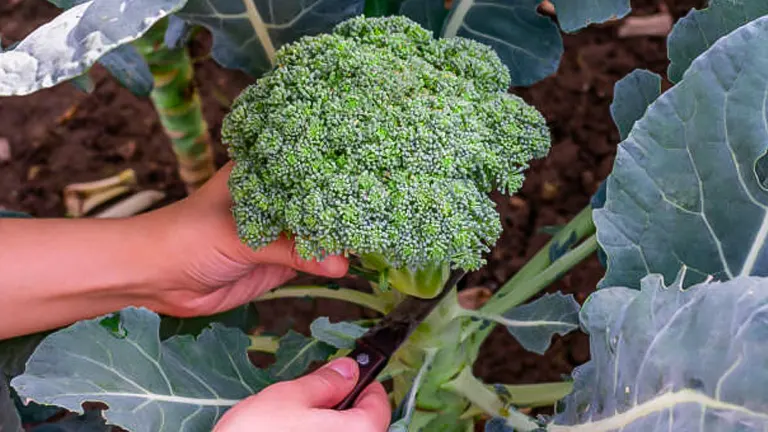
Timing: Harvesting broccoli at the right time is crucial to ensure you capture the maximum flavor and nutrition. Begin monitoring the central head when it reaches around 4-8 inches in diameter. The head should appear tight and compact, and the buds should be green and firm. If the buds start to open or turn yellow, this indicates that the head is beginning to flower, and the quality will decline quickly.
Cutting Techniques:
- Use a clean, sharp knife or pruners to cut the central head about 6 inches below the floret cluster.
- Make a clean, angled cut to prevent water from pooling on the stalk, which can cause rot.
- After removing the main head, leave the plant intact as it will produce smaller side shoots that can continue to be harvested over the next few weeks.
Post-Harvest Care
Storing Fresh Broccoli:
- Short-Term Storage: Store fresh broccoli in the refrigerator to maintain its crispness and flavor. Wrap the heads in a damp paper towel and place them in a perforated plastic bag to keep them hydrated.
- Long-Term Storage: For extended storage, blanch broccoli florets briefly in boiling water, then plunge them into ice water to halt the cooking process. Once fully cooled, drain and freeze them in airtight containers or freezer bags.
Succession Planting:
- To ensure a consistent supply of broccoli throughout the growing season, consider succession planting. This means sowing seeds or transplanting seedlings every 2-3 weeks. By staggering plantings, you can harvest fresh broccoli continuously and avoid a surplus at any one time.
Final Tips for Success
Crop Rotation: Practice crop rotation to prevent soil-borne diseases and pest buildup. Rotate broccoli with crops from different families, like legumes or root vegetables, to keep soil healthy and productive.
Seed Saving: If you’re growing heirloom or open-pollinated varieties, consider saving seeds for future plantings. Let a few heads mature fully and flower, then collect the dried seeds once the pods turn brown.
Continued Learning: Gardening is an evolving journey. Keep experimenting with different planting schedules, varieties, and care techniques. Take notes on what worked well each season and what could be improved, helping you refine your growing methods over time.
Related Post
- How to Fertilize Bougainvillea: A Complete Guide for Stunning Blooms
- How to Fertilize Apple Trees: Essential Tips for a Bountiful Harvest
- How to Fertilize Lemon Trees: Secrets for Thriving Citrus
- How to Fertilize Avocado Tree: A Step-by-Step Guide for Lush Growth
Conclusion
In cultivating broccoli, the right knowledge and techniques are essential for ensuring a thriving, nutritious crop. From selecting the appropriate variety to implementing precise planting methods and diligent care throughout the growing season, success lies in understanding the plant’s needs and adapting to your specific environment. By staying vigilant for pests, diseases, and environmental changes, while also optimizing watering and fertilization practices, you can achieve a robust harvest with flavorful heads that continue to produce side shoots. Ultimately, growing broccoli becomes a rewarding experience when expert secrets are applied, resulting in healthy plants that enrich your diet and garden.
FAQs
- What is the best time of year to plant broccoli?
Broccoli should be planted in cool weather. In most climates, you can plant seeds indoors 6-8 weeks before the last spring frost date or plant seedlings outdoors 2-3 weeks before the last frost. For a fall harvest, plant about 10-12 weeks before the first expected fall frost. - How much sunlight does broccoli need?
Broccoli requires full sun, meaning at least 6 to 8 hours of direct sunlight per day. However, in very hot climates, afternoon shade can help prevent the plants from bolting (flowering) too early. - Can broccoli be grown in containers?
Yes, broccoli can be successfully grown in containers. Choose a container that is at least 12 inches deep and 18 inches wide to accommodate the plant’s root system. Ensure the container has good drainage and use high-quality potting soil. - What should I do if my broccoli plants start to flower?
If broccoli plants start to flower, it’s called bolting, which is often triggered by high temperatures. Harvest the broccoli as soon as possible once flowering begins, as the quality will decline rapidly after flowers appear. - How often should I water my broccoli plants?
Water broccoli plants deeply about once or twice a week, providing 1 to 1.5 inches of water each time, depending on soil type and climate. The goal is to keep the soil moist but not waterlogged. - What are common pests that affect broccoli, and how can I manage them?
Common pests include cabbage loopers, aphids, and flea beetles. Manage these by using floating row covers to protect the plants, applying organic pesticides like Bacillus thuringiensis for caterpillars, and encouraging beneficial insects that prey on aphids and other pests. - How do I know when broccoli is ready to harvest?
Broccoli is ready to harvest when the head is firm and tight, before the flowers start to open. The head should feel dense and have a diameter of 4-7 inches, depending on the variety. - Can I use mulch around my broccoli plants?
Yes, mulching around broccoli plants is beneficial for retaining soil moisture, controlling weeds, and keeping soil temperatures stable. Organic mulches like straw or bark chips are ideal as they also add nutrients to the soil as they decompose.
With these expert tips and insights, you’re now equipped to grow and nurture your own broccoli crop. Remember, the key to a bountiful harvest lies in consistent care and attentiveness to the needs of your plants. Happy gardening, and enjoy the rewards of your hard work with delicious, home-grown broccoli!
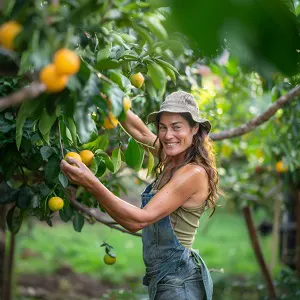
Emma Hudson
Forestry AuthorEmma's experience in farming shapes her detailed guides on gardening and farming tools, providing practical, actionable advice grounded in real-world experience. Her work targets both newcomers and experienced farmers, aiming to enhance their practices with a mix of traditional wisdom and modern techniques. By making complex agricultural concepts accessible, Emma's guides serve as valuable tools for those navigating the challenges of contemporary farming, offering strategies for sustainable success.



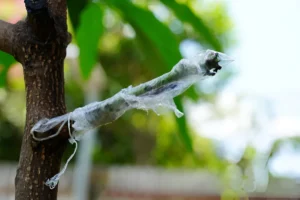









Leave your comment